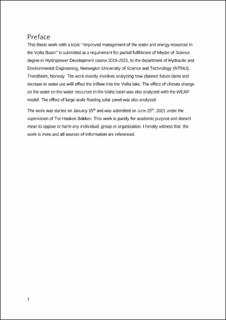| dc.description.abstract | Abstract
Integrated water management, energy and food nexus has been a major discussion due to the sustainable development goals (SDG’s), especially SDG2, SDG6, SDG7 and SDG13. The population in the Volta river basin is mainly dependent on rainfed agriculture and therefore, the basin is vulnerable due to the variability in rainfall and climate change. Development of Dams has become of high priority in the basin for irrigating, municipal water supply, flood protection and livestock watering. The effect of future dams in the sub- basins are vital to the inflows into the Volta lake.
The main objectives of this study were to analyze how planned future dams and increase in water use will affect the inflow into the Volta lake. The effect of climate change on the water on the water resources in the Volta basin was also analyzed. The effect of large-scale floating solar panel was also analyzed.
A hydrological model of the three sub basins in the Volta basin was established using the Water Evaluation and Planning tool (WEAP). The percentage bias (PBIAS) statistical criterion was used to assess the calibration which shows an acceptable model for the White, Black and Oti basins.
The model simulated historical streamflow, current and future dams, irrigation, municipal and domestic water use for the three sub basins.
Future climate data (rainfall and temperature for the period 2020-2039 and 2080-2099 was generated from the World Bank Group climate change portal with ensemble mean model and RCP 4.5 scenario. Three scenarios were analyzed, i.e. the present scenario (1960-2010) and future scenarios from 2020-2039 and 2080-2099.
The result of the study indicates that streamflow in the volta basin with future planned dams will not influence the streamflow. However, there is an overall increase of 0.89%. in monthly average streamflow for the White Volta basin.
On the other hand, the Volta basin will experience temperature rise and low precipitation due to climate change which has a drastic effect in the period 2020-2039 and 2080-2099.
The introduction of a 35km2 large-scale floating solar panel of is vital in conserving water during droughts in the basin due to climate change. It will save water of about 6.7 x 107 m3/year which is quite significant to the municipality. | |
